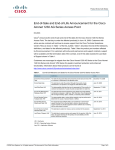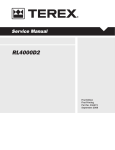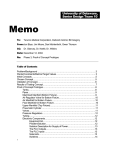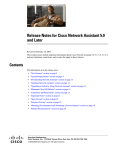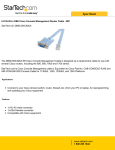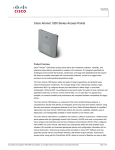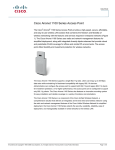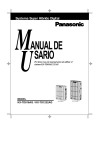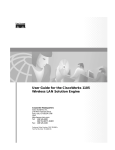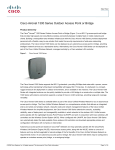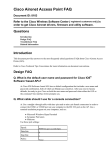Download Cisco 802.11a/g Modular LWAPP AP, RP-TNC, FCC Cnfg
Transcript
Data Sheet Cisco Aironet 1230AG Series 802.11A/B/G Access Point ® ® Cisco Aironet 1230AG Series Access Points deliver the versatility, high capacity, security, and enterprise-class features demanded by WLAN customers. These IEEE 802.11a/b/g access points are designed specifically for challenging RF environments such as factories, warehouses, and large retail establishments that require the antenna versatility associated with connectorized antennas, a rugged metal enclosure, and a broad operating temperature range. The Cisco Aironet 1230AG Series is a component of the Cisco Unified Wireless Network, a comprehensive solution that delivers an integrated, end-to-end wired and wireless network. Using the radio and network management features of the Cisco Unified Wireless Network for simplified deployment, the Cisco Aironet 1230AG Series extends the security, scalability, reliability, ease of deployment, and manageability available in wired networks to the wireless LAN. The Cisco Aironet 1230AG Series is available in two versions: unified or autonomous. Unified access points operate with the Lightweight Access Point Protocol (LWAPP) and work in conjunction with Cisco wireless LAN controllers and the Cisco Wireless Control System (WCS). When configured with LWAPP, the Cisco Aironet 1230AG Series can automatically detect the best-available Cisco wireless LAN controller and download appropriate policies and configuration ® information with no manual intervention. Autonomous access points are based on Cisco IOS Software and may optionally operate with the CiscoWorks Wireless LAN Solution Engine (WLSE). Autonomous access points, along with the CiscoWorks WLSE, deliver a core set of features and may be field-upgraded to take advantage of the full benefits of the Cisco Unified Wireless Network as requirements evolve. Award-Winning Security The Cisco Aironet 1230AG Series has achieved National Institute of Standards and Technology (NIST) FIPS 140-2 level 2 and is in process for Information Assurance validation under the National Information Assurance Partnership (NIAP) Common Criteria program. All contents are Copyright © 1992–2006 Cisco Systems, Inc. All rights reserved. This document is Cisco Public Information. Page 1 of 8 Data Sheet The Cisco Aironet 1230AG Series supports 802.11i, Wi-Fi Protected Access (WPA), WPA2, and numerous Extensible Authentication Protocol (EAP) types. WPA and WPA2 are the Wi-Fi Alliance certifications for interoperable, standards-based WLAN security. These certifications support IEEE 802.1X for user-based authentication, Temporal Key Integrity Protocol (TKIP) for WPA encryption, and Advanced Encryption Standard (AES) for WPA2 encryption. These certifications help to ensure interoperability between Wi-Fi-certified WLAN devices from different manufacturers. The Cisco Aironet 1230AG Series hardware-accelerated AES encryption supports enterpriseclass, government-grade secure encryption over the WLAN without compromising performance. IEEE 802.1X authentication helps to ensure that only authorized users are allowed on the network. Backward compatibility and support for WPA client devices running TKIP, the RC4 encryption algorithm, is also supported by the Cisco Aironet 1230AG Series. Cisco Aironet 1230AG Series Access Points operating with LWAPP support Cisco Unified Intrusion Detection System/Intrusion Prevention System (IDS/IPS), a software feature that is part of the Cisco Self-Defending Network and is the industry’s first integrated wired and wireless security solution. Cisco Unified IDS/IPS takes a comprehensive approach to security—at the wireless edge, wired edge, WAN edge, and through the data center. When an associated client sends malicious traffic through the Cisco Unified Wireless Network, a Cisco wired IDS device detects the attack and sends shun requests to Cisco wireless LAN controllers, which will then disassociate the client device. Autonomous or unified Cisco Aironet 1230AG Series Access Points support management frame protection for the authentication of 802.11 management frames by the wireless network infrastructure. This allows the network to detect spoofed frames from access points or malicious users impersonating infrastructure access points. If an access point detects a malicious attack, an incident will be generated by the access point and reports will be gathered on the Cisco wireless LAN controller, Cisco WCS, or CiscoWorks WLSE. Applications Designed for rugged environments and installations that require antenna versatility, the Cisco Aironet 1230AG Series features antenna connectors for extended range or coverage versatility and more flexible installation options. Manufacturing applications, for example, can place WLANs in hazardous locations and remotely place antennas in the hazardous locations while securing the Cisco Aironet 1230AG Series access points within the wiring closet. The two remain connected via low-loss antenna cables. The metal housing and industrial-grade components of the Cisco Aironet 1230AG Series provide the ruggedness and extended operating temperature range required in factories, warehouses, “big box” retail environments and similar facilities. High transmit power, receive sensitivity and delay spread for both 2.4 GHz and 5 GHz radios provide the long range and large coverage area consistent with these applications. Access points may be placed above ceilings or suspended ceilings, allowing antennas to be discreetly placed below drop ceilings. The UL 2043 rating of the Cisco Aironet 1230AG Series allows the access points to be placed above ceilings in plenum areas regulated by municipal fire codes. Public access applications such as large hotel buildings may also present a challenging RF environment; the antenna versatility of the Cisco Aironet 1230AG Series, together with industryleading range and coverage, provides reliable performance for the most demanding environments. All contents are Copyright © 1992–2006 Cisco Systems, Inc. All rights reserved. This document is Cisco Public Information. Page 2 of 8 Data Sheet Features and Benefits Table 1 lists the features and benefits of Cisco Aironet 1230AG Series access points. Table 1. Features and Benefits of Cisco Aironet 1230AG Series Access Points Feature Benefit Dual 802.11a and 802.11g Radios Provides up to 108 Mbps of capacity in a single device for industry-leading capacity and compatibility with older 802.11b clients. Dual RP-TNC Antenna Connectors for Both 2.4-GHz and 5-GHz Radios Antenna connectors support a variety of Cisco 2.4-GHz and 5-GHz antennas, providing range and coverage versatility. Link-Role Flexibility Autonomous access points can function as an access point or bridge, whether set up as a single-band or dual-band platform, allowing each radio to be individually configured as an access point repeater, root bridge, non-root bridge, or workgroup bridge, enabling a broad array of applications. Cisco Unified IDS/IPS This integrated software feature is part of the Cisco Self-Defending Network and is the industry’s first integrated wired and wireless security solution. When a trusted client acts maliciously, the wired IDS detects the attack and sends shun requests to Cisco WLAN controllers, which will then disassociate the client device. Management Frame Protection This feature provides for the authentication of 802.11 management frames by the wireless network infrastructure. This allows the network to detect spoofed frames from access points or malicious users impersonating infrastructure access points. If an access point detects a malicious attack, an incident will be generated by the access points and reports will be gathered on the Cisco wireless LAN controller, Cisco WCS, or CiscoWorks WLSE. Security Authentication Security Standards ● WPA ● WPA2 (802.11i) ● Cisco TKIP ● Cisco message integrity check (MIC) ● IEEE 802.11 WEP keys of 40 bits and 128 bits 802.1X EAP types: ● EAP-Flexible Authentication via Secure Tunneling (EAP-FAST) ● Protected EAP-Generic Token Card (PEAP-GTC) ● PEAP-Microsoft Challenge Authentication Protocol Version 2 (PEAP-MSCHAP) ● EAP-Transport Layer Security (EAP-TLS) ● EAP-Tunneled TLS (EAP-TTLS) ● EAP-Subscriber Identity Module (EAP-SIM) ● Cisco LEAP Encryption: ● AES-CCMP encryption (WPA2) ● TKIP (WPA) ● Cisco TKIP ● WPA TKIP ● IEEE 802.11 WEP keys of 40 bits and 128 bits Currently Supports 12 NonOverlapping Channels, with Potentially up to 23 Channels Lower potential interference with neighboring access points simplifies deployment. Fewer transmission errors deliver greater throughput. Rugged Metal Housing Cast aluminum case and rugged features support deployment in factories, warehouses, the outdoors (in a NEMA enclosure), and other industrial environments. UL 2043 Plenum Rating and Extended Operating Temperature Supports installation in environmental air spaces such as areas above suspended ceilings. Multipurpose and Lockable Mounting Bracket Provides greater flexibility in installation options for site specific options, as well as theft deterrence. Both Local and Inline Power Support Power can be supplied using the Ethernet cable, eliminating the need for costly electrical power line runs to remotely installed access points. The access points can be powered by Cisco inline power switches, single port power injectors, or local power. Hardware-Assisted AES Encryption Provides high security without performance degradation. All contents are Copyright © 1992–2006 Cisco Systems, Inc. All rights reserved. This document is Cisco Public Information. Page 3 of 8 Data Sheet Summary/Conclusion Cisco Aironet 1230AG Series access points feature antenna connectors for greater range or coverage versatility using a broad selection of available Cisco antennas, as well as a rugged metal housing for operation over extended temperature ranges typical of industrial environments. Dual 802.11a and 802.11g radios deliver a combined capacity of 108 Mbps, meeting the performance requirements of the most demanding applications, while hardware-assisted AES encryption provides uncompromised support for interoperable IEEE 802.11i and WPA2 security. Product Specifications Table 2 lists the product specifications for Cisco Aironet 1230AG access points. Table 2. Product Specifications for Cisco Aironet 1230AG Access Points Item Part Number Specification ● AIR-AP1232AG-x-K9 (Cisco IOS Software) ● AIR-LAP1232AG-x-K9 (Cisco Unified Wireless Network Software) Note: The Cisco Aironet 1230AG Series may be ordered with Cisco IOS Software to operate as an autonomous AP or with Cisco Unified Wireless Network Software using the Lightweight Access Point Protocol (LWAPP). When the 1230AG is operating as a lightweight AP a WLAN controller is required. Regulatory domains: (x = regulatory domain) ● A = FCC ● C = China ● E = ETSI ● I = Israel ● K = Korea ● J = TELEC (Japan) for AP 1232AG only ● N = North America (Excluding FCC) ● P = Japan2 ● S = Singapore ● T = Taiwan Customers are responsible for verifying approval for use in their individual countries. To verify approval and to identify the regulatory domain that corresponds to a particular country, please visit: http://www.cisco.com/go/aironet/compliance Not all regulatory domains have been approved. As they are approved, the part numbers will be available on the Global Price List. Software ● Cisco IOS Software Release 12.3(8)JA or later (autonomous). ● Cisco IOS Software Release 12.3(11)JX or later (Lightweight Mode). ● Cisco Unified Wireless Network Software Release 4.0 or later. Data Rates Supported ● 802.11a: 6, 9, 12, 18, 24, 36, 48, and 54 Mbps ● 802.11g: 1, 2, 5.5, 6, 9, 11, 12, 18, 24, 36, 48, and 54 Mbps Network Standard IEEE 802.11a, 802.11b, and 802.11g Uplink Autosensing 802.3 10/100BASE-T Ethernet Radio Module Form Factor ● 802.11a: CardBus (32-bit) ● 802.11g: Mini-PCI (32-bit) All contents are Copyright © 1992–2006 Cisco Systems, Inc. All rights reserved. This document is Cisco Public Information. Page 4 of 8 Data Sheet Item Specification Frequency Band and Operating Channels Americas (FCC) ● 2.412 to 2.462 GHz; 11 channels ● 5.15 to 5.35, 5.725 to 5.825 GHz; 12 channels China ● 2.412 to 2.472 GHz; 13 channels ● 5.725 to 5.825 GHz; 4 channels ETSI ● 2.412 to 2.472 GHz; 13 channels ● 5.15 to 5.35 GHz; 8 channels ● 5.470 to 5.725 MHz; 11 channels Israel ● 2.432 to 2.472 GHz; 9 channels ● 5.15 to 5.35 GHz; 8 channels Japan (TELEC) ● 2.412 to 2.472 GHz; 13 channels Orthogonal Frequency Division Multiplexing (OFDM) ● 2.412 to 2.484 GHz; 14 channels Complementary Code Keying (CCK) ● 5.15 to 5.25 GHz; 4 channels Japan-P (TELEC 2 [Japan2] Cnfg) ● 2.412 to 2.472 GHz; 13 channels Orthogonal Frequency Division Multiplexing Korea ● 2.412 to 2.472 GHz; 13 channels ● 5.15 to 5.35, 5.46 to 5.72, 5.725 to 5.825; 19 channels North America ● 2.412 to 2.462 GHz; 11 channels ● 5.15 to 5.35, 5.725 to 5.825 GHz; 12 channels Singapore ● 2.412 to 2.472 GHz; 13 channels ● 5.15 to 5.35, 5.725 to 5.825 GHz; 12 channels Taiwan ● 2.412 to 2.462 GHz; 11 channels ● 5.25 to 5.35 GHz; 7 channels ● 5.725 to 5.825 GHz; 4 channels NonOverlapping Channels ● 802.11a: 12 channels (FCC; other regulatory domains support different numbers of 802.11a channels) ● FCC currently supports 12 non-overlapping channels, with potentially up to 23 channels via a future firmware release depending on FCC rules Wireless Modulation ● 802.11a: OFDM ● 802.11g: Direct sequence spread spectrum (DSSS); OFDM Receive Sensitivity (Typical) Available Transmit Power Settings (Maximum Power Setting will Vary by Channel and According to Individual Country Regulations) 802.11a ● 6 Mbps: –87 dBm ● 9 Mbps: –84 dBm ● 12 Mbps: –82 dBm ● 18 Mbps: –84 dBm ● 24 Mbps: –81 dBm ● 18 Mbps: –80 dBm ● 24 Mbps: –77 dBm ● 36 Mbps: –78 dBm ● 48 Mbps: –73 dBm ● 36 Mbps: –73 dBm ● 48 Mbps: –72 dBm ● 54 Mbps: –72 dBm ● 54 Mbps: –72 dBm 802.11a: 802.11b: OFDM: ● 17 dBm (50 mW) CCK: ● 100 mW (20 dBm) ● 50 mW (17 dBm) ● 11 dBm (12 mW) ● 8 dBm (6 mW) ● 5 dBm (3 mW) ● 2 dBm (2 mW) ● –1 dBm (1 mW) Range 802.11g ● 6 Mbps: –90 dBm ● 9 Mbps: –87 dBm ● 12 Mbps: –85 dBm ● 15 dBm (30 mW) ● 14 dBm (25 mW) 802.11b/g: 3 channels ● 30 mW (15 dBm) ● 20 mW (13 dBm) ● 10 mW (10 dBm) 802.11g: ● 30 mW (15 dBm) ● 20 mW (13 dBm) ● 10 mW (10 dBm) ● 5 mW (7 dBm) ● 1 mW (–1 dBm) ● 5 mW (7 dBm) ● 1 mW (0 dBm) Indoor: All contents are Copyright © 1992–2006 Cisco Systems, Inc. All rights reserved. This document is Cisco Public Information. Outdoor: Page 5 of 8 Data Sheet Item Specification 802.11a: ● 90 ft (27 m) at 54 Mbps ● 225 ft (69 m) at 48 Mbps ● 300 ft (91 m) at 36 Mbps ● 350 ft (107 m) at 24 Mbps ● 400 ft (122 m) at 18 Mbps ● 450 ft (137 m) at 12 Mbps ● 475 ft (145 m) at 9 Mbps ● 500 ft (152 m) at 6 Mbps 802.11g: ● 90 ft (27 m) at 54 Mbps ● 95 ft (29 m) at 48 Mbps ● 100 ft (30 m) at 36 Mbps ● 140 ft (43 m) at 24 Mbps ● 180 ft (55 m) at 18 Mbps ● 210 ft (64 m) at 12 Mbps ● 220 ft (67 m) at 11 Mbps ● 250 ft (76 m) at 9 Mbps ● 300 ft (91 m) at 6 Mbps ● 310 ft (94 m) at 5.5 Mbps ● 350 ft (107 m) at 2 Mbps ● 410 ft (125 m) at 1 Mbps 802.11a: ● 170 ft (52 m) at 54 Mbps ● 350 ft (107 m) at 48 Mbps ● 550 ft (167 m) at 36 Mbps ● 700 ft (213 m) at 24 Mbps ● 800 ft (244 m) at 18 Mbps ● 875 ft (267 m) at 12 Mbps ● 925 ft (282 m) at 9 Mbps ● 950 ft (290 m) at 6 Mbps 802.11g: ● 110 ft (34 m) at 54 Mbps ● 200 ft (61 m) at 48 Mbps ● 225 ft (69 m) at 36 Mbps ● 325 ft (99 m) at 24 Mbps ● 400 ft (122 m) at 18 Mbps ● 475 ft (145 m) at 12 Mbps ● 490 ft (149 m) at 11 Mbps ● 550 ft (168 m) at 9 Mbps ● 650 ft (198 m) at 6 Mbps ● 660 ft (201 m) at 5.5 Mbps ● 690 ft (210 m) at 2 Mbps ● 700 ft (213 m) at 1 Mbps Ranges and actual throughput vary based upon numerous environmental factors so individual performance may differ. Compliance Standards Safety ● UL 60950-1 ● CAN/CSA-C22.2 No. 60950-1 ● IEC 60950-1 ● EN 60950-1 ● UL 2043 ● NIST FIPS 140-2 level 2 validation FIPS 140-2 Pre-Validation List ● Common Criteria (Cisco IOS Software only) Radio Approvals ● FCC Part 15.247 ● RSS-210 (Canada) ● EN 300.328, EN 301.893 (Europe) ● ARIB-STD 33 (Japan) ● ARIB-STD 66 (Japan) ● ARIB-STD T71 (Japan) ● AS/NZS 4771, 4268.2 (Australia and New Zealand) EMI and Susceptibility (Class B) ● FCC Part 15.107 and 15.109 ● ICES-003 (Canada) ● VCCI (Japan) ● EN 301.489-1 and -17 (Europe) ● AS/NZS 3548 ● EN 60601-1-2 EMC requirements for the Medical Directive 93/42/EEC Security ● 802.11i, WPA2, WPA ● 802.1X ● AES, TKIP Other ● IEEE 802.11g and IEEE 802.11a ● FCC Bulletin OET-65C ● RSS-102 All contents are Copyright © 1992–2006 Cisco Systems, Inc. All rights reserved. This document is Cisco Public Information. Page 6 of 8 Data Sheet Item Specification Antennas 2.4 GHz ● Dual RP-TNC connectors 5 GHz ● Dual RP-TNC connectors LEDs Three indicators on the top panel report Ethernet activity and status, device operating status, and radio activity and status. Housing Die-cast aluminum Dimensions (H x W x D) 1.660 x 6.562 x 7.232 in. (4.22 x 16.67 x 18.37 cm); add 0.517 in. (1.31 cm) to the height for mounting bracket Weight 1.725lbs (0.783kg); add 0.4lbs (0.181kg) for mounting bracket ● Non-operating (storage) temperature: –40 to 185°F (– 40 to 85°C) ● Operating temperature: –4 to 131°F (–20 to 55°C) Environmental ● Operating humidity: 10 to 90 percent (non-condensing) Memory and Processor ● IBM PowerPC405 (200 MHz) ● 16 MB RAM; 8 MB Flash memory Input Power Requirements ● 90 to 240 VAC ±10 percent (power supply) ● 48 VDC ±10 percent Power Draw 13W maximum Warranty One year Wi-Fi Certification Ordering Information To place an order, visit the Cisco Ordering Home Page. Table 3 provides ordering information for Cisco Aironet 1230AG Series access points. Table 3. Product Part Numbers for Cisco Aironet 1230AG Access Points Part Number Product Description AIR-AP1232AG-A-K9 802.11a/g Modular IOS AP; RP-TNC; FCC Cnfg AIR-AP1232AG-C-K9 802.11a/g Modular IOS AP; RP-TNC; China Cnfg AIR-AP1232AG-E-K9 802.11a/g Modular IOS AP; RP-TNC; ETSI Cnfg AIR-AP1232AG-I-K9 802.11a/g Modular IOS AP; RP-TNC; Israel Cnfg AIR-AP1232AG-J-K9 802.11a/g Modular IOS AP; RP-TNC; Japan AIR-AP1232AG-K-K9 802.11a/g Modular IOS AP; RP-TNC; Korea Cnfg AIR-AP1232AG-N-K9 802.11a/g Modular IOS AP; RP-TNC; N. America Cnfg (not FCC) AIR-AP1232AG-P-K9 802.11a/g Modular IOS AP; RP-TNC; Japan2 Cnfg AIR-AP1232AG-S-K9 802.11a/g Modular IOS AP; RP-TNC; Singapore Cnfg AIR-AP1232AG-T-K9 802.11a/g Modular IOS AP; RP-TNC; Taiwan Cnfg AIR-LAP1232AG-A-K9 802.11a/g Modular LWAPP AP; RP-TNC; FCC Cnfg AIR-LAP1232AG-C-K9 802.11a/g Modular LWAPP AP; RP-TNC; China Cnfg AIR-LAP1232AG-E-K9 802.11a/g Modular LWAPP AP; RP-TNC; ETSI Cnfg AIR-LAP1232AG-I-K9 802.11a/g Modular LWAPP AP; RP-TNC; Israel Cnfg AIR-LAP1232AG-J-K9 802.11a/g Modular LWAPP AP; RP-TNC; Japan AIR-LAP1232AG-K-K9 802.11a/g Modular LWAPP AP; RP-TNC; Korea Cnfg AIR-LAP1232AG-N-K9 802.11a/g Modular LWAPP AP; RP-TNC; N. America Cnfg (not FCC) AIR-LAP1232AG-P-K9 802.11a/g Modular LWAPP AP; RP-TNC; Japan2 Cnfg AIR-LAP1232AG-S-K9 802.11a/g Modular LWAPP AP; RP-TNC; Singapore Cnfg All contents are Copyright © 1992–2006 Cisco Systems, Inc. All rights reserved. This document is Cisco Public Information. Page 7 of 8 Data Sheet Part Number Product Description AIR-LAP1232AG-T-K9 802.11a/g Modular LWAPP AP; RP-TNC; Taiwan Cnfg To Download the Software Visit the Cisco Software Center (login required) to download Cisco IOS Software. Service and Support ® Cisco Systems offers a wide range of services programs to accelerate customer success. These innovative services programs are delivered through a unique combination of people, processes, tools, and partners, resulting in high levels of customer satisfaction. Cisco services help you protect your network investment, optimize network operations, and prepare your network for new applications to extend network intelligence and the power of your business. For more information about Cisco services, visit Cisco Technical Support Services or Cisco Advanced Services. For More Information For more information about the Cisco Aironet 1230AG Series, visit http://www.cisco.com/go/wireless or contact your local account representative. Printed in USA All contents are Copyright © 1992–2006 Cisco Systems, Inc. All rights reserved. This document is Cisco Public Information. C78-348344-02 12/06 Page 8 of 8








